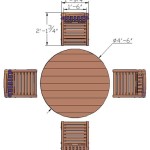Red Brick Paver Patio Ideas: Design and Installation Guide
Red brick pavers offer a timeless aesthetic and durable surface for outdoor patios. Their classic appeal complements a wide range of architectural styles, from traditional to modern, providing warmth and character to any landscape. This article explores various design ideas and installation considerations for red brick paver patios, offering guidance for achieving a visually appealing and structurally sound outdoor living space.
Design Considerations for Red Brick Paver Patios
The design phase is crucial for a successful brick paver patio. Several factors influence the final appearance and functionality of the patio, including size, shape, pattern, and border treatments. Thoughtful planning ensures the patio meets the homeowner's needs and complements the surrounding environment.
Size and Shape: Determining the appropriate size of the patio depends on its intended use. A small patio may suffice for a bistro set and a few potted plants, while a larger patio can accommodate outdoor dining, lounging areas, and even a fire pit. Consider the existing landscape and the movement patterns of people using the space. Rectangular and square patios are common choices, offering efficient use of space and ease of construction. However, curved or irregularly shaped patios can create a more natural and organic feel, especially when integrated with existing garden beds or landscaping features. Before committing to a specific size and shape, it is advisable to mark the proposed area with stakes and string or landscape paint to visually assess its impact on the overall yard.
Paver Patterns: Brick pavers are available in various sizes and shapes, allowing for a multitude of laying patterns. The pattern chosen significantly impacts the overall aesthetic of the patio. The running bond pattern, where bricks are offset by half their length in each row, is a classic and simple choice, providing a clean and uniform look. Herringbone patterns, characterized by bricks laid at a 45-degree angle to each other, offer a more visually dynamic and intricate design. Basketweave patterns, featuring alternating pairs of bricks laid perpendicular to each other, create a textured and visually interesting surface. Circular patterns, often used as focal points within a larger patio, add a touch of elegance and sophistication. The chosen pattern should align with the desired level of formality and the overall aesthetic of the home and landscape.
Border Treatments: A well-defined border adds a finishing touch to a brick paver patio and can enhance its visual appeal. Borders can be created using different materials, such as contrasting colored bricks, stone edging, or concrete pavers. A border can also be achieved by simply changing the paver pattern around the perimeter of the patio. Borders serve not only an aesthetic purpose but also a structural one, helping to contain the patio and prevent pavers from shifting over time. For a more formal look, consider using a straight edge border with neatly aligned bricks. For a more rustic or natural look, consider using irregular stone edging or a border of plants.
Color and Texture Variations: While the focus is on red brick pavers, consider that even within the "red brick" category, there is a wide range of shades and textures. Some bricks may be a uniform deep red, while others may exhibit variations in color, including browns, oranges, and even hints of black. These variations can add depth and character to the patio. Consider mixing different shades of red brick to create a more visually interesting and dynamic surface. The texture of the brick also plays a role in the overall aesthetic. Some bricks have a smooth, uniform surface, while others have a more textured or weathered appearance. Choosing a brick with a slightly textured surface can provide better traction and prevent slipping, especially in wet conditions.
Integration with Landscaping: A brick paver patio should seamlessly integrate with the surrounding landscaping. Consider incorporating plants, trees, and shrubs into the patio design to soften the edges and create a more natural and inviting atmosphere. Planting beds can be strategically placed around the perimeter of the patio, or even interspersed within the patio itself, to add color and texture. Climbing plants, such as ivy or wisteria, can be trained to grow on trellises or walls adjacent to the patio, creating a vertical element and adding visual interest. Consider the mature size and growth habits of plants when selecting them for placement near the patio to avoid future problems with roots damaging the paver surface.
Installation Process for Red Brick Paver Patios
Proper installation is essential for the longevity and stability of a brick paver patio. A poorly installed patio can lead to uneven surfaces, shifting pavers, and eventual failure. The installation process involves several key steps, including site preparation, base construction, paver laying, and joint filling.
Site Preparation: The first step in the installation process is to prepare the site. This involves excavating the area to the desired depth, typically 6-8 inches, depending on the type of base material used. Remove any vegetation, topsoil, and debris from the area. Compacting the subgrade soil is crucial for providing a stable foundation for the patio. Use a plate compactor to ensure the soil is firm and level. Proper grading is essential for drainage. Ensure the patio slopes slightly away from the house or any other structures to prevent water from pooling on the surface.
Base Construction: A well-constructed base is the foundation of a durable brick paver patio. The base provides support for the pavers and prevents them from sinking or shifting over time. The most common base material is crushed stone, typically a 3/4-inch gravel. Spread the crushed stone evenly over the compacted subgrade and compact it thoroughly with a plate compactor. The thickness of the crushed stone base should be at least 4 inches, but may need to be thicker in areas with heavy clay soil or poor drainage. Once the crushed stone base is compacted, a layer of bedding sand is added. The bedding sand provides a level surface for the pavers to rest on. Use a screed board to create a smooth and even layer of bedding sand, typically about 1 inch thick. Avoid compacting the bedding sand, as this can make it difficult to adjust the pavers during installation.
Paver Laying: Once the base is prepared, the pavers can be laid in the desired pattern. Start by laying the pavers along the perimeter of the patio, working your way inward. Use a rubber mallet to gently tap the pavers into place, ensuring they are level and flush with each other. Maintain consistent spacing between the pavers, typically about 1/4 inch. Use paver spacers to ensure uniform joint widths. Periodically check the level of the pavers with a level and make adjustments as needed. Cutting pavers may be necessary to fit around curves or edges. Use a paver saw or a chisel and hammer to cut the pavers to the desired shape and size. When laying the pavers, avoid walking on the bedding sand, as this can disturb the level surface.
Joint Filling and Compaction: After laying all the pavers, the joints between the pavers need to be filled with jointing sand. Jointing sand helps to stabilize the pavers and prevent weeds from growing in the joints. Use a broom to sweep the jointing sand into the joints, filling them completely. Compact the pavers with a plate compactor to lock them into place and further settle the jointing sand. Use a protective mat under the plate compactor to prevent scratching or damaging the pavers. After compacting the pavers, sweep away any excess jointing sand from the surface. Water the patio lightly to help settle the jointing sand and further stabilize the pavers. Repeat the joint filling and compaction process as needed to ensure all the joints are completely filled.
Sealing (Optional): Sealing a brick paver patio is optional, but it can provide several benefits, including protecting the pavers from staining, fading, and weathering. Sealing can also enhance the color and appearance of the pavers. Choose a sealer specifically designed for brick pavers and follow the manufacturer's instructions carefully. Before sealing the patio, ensure it is clean and dry. Apply the sealer evenly over the surface of the pavers using a roller or sprayer. Allow the sealer to dry completely before using the patio.
Maintaining a Red Brick Paver Patio
Regular maintenance is essential for preserving the beauty and integrity of a red brick paver patio. Proper maintenance involves cleaning, weed control, and occasional repairs.
Cleaning: Regular cleaning helps to remove dirt, debris, and stains from the patio surface. Sweep the patio regularly with a broom to remove loose dirt and leaves. Wash the patio occasionally with a garden hose and mild detergent. For stubborn stains, use a pressure washer, but be careful not to damage the pavers or joints. When using a pressure washer, use a wide nozzle and keep the pressure low. Avoid using harsh chemicals or abrasive cleaners, as these can damage the pavers. Organic stains, such as algae or mildew, can be removed with a solution of bleach and water. Apply the solution to the affected area, let it sit for a few minutes, and then scrub with a brush and rinse with water.
Weed Control: Weeds can grow in the joints between the pavers, detracting from the appearance of the patio. Regular weed control is essential for maintaining a clean and well-maintained patio. Pull weeds by hand or use a weeding tool. Apply a herbicide to kill weeds, but be careful not to spray the herbicide on the pavers. Use a pre-emergent herbicide to prevent weeds from growing in the joints. Fill the joints with polymeric sand to prevent weeds from growing. Polymeric sand is a type of jointing sand that hardens when wet, creating a barrier that prevents weeds from sprouting.
Repairs: Over time, some pavers may become loose, cracked, or damaged. Repairing damaged pavers promptly can prevent further damage and maintain the stability of the patio. Remove the damaged paver using a chisel and hammer. Clean the area where the paver was removed. Add fresh bedding sand and level it with a trowel. Replace the paver with a new one, tapping it into place with a rubber mallet. Fill the joints around the new paver with jointing sand. Sealing the patio can help to protect the pavers from damage and extend their lifespan. Reapply sealer every few years, or as needed, according to the manufacturer's instructions.

Winnetka Red Brick Paver Patio And Outdoor Room Van Zelst

75 Red Brick Patio Ideas You Ll Love December 2024 Houzz

Red Brick Patio Ideas Diy Paver Designs Pictues Patios Pavers Design

Achieve An Enchanted Charm Look With Brick For Your Dublin Oh Paver Patio Arj Landscape

Brick Paver Patio Designs Bethesda Md Installation

Brick Herringbone Or Chevron Patio Pavers Design Patterns Patios

We Have A Red Brick Paver Patio Yellow Home

9 Brick Patio Ideas For A Beautiful Backyard Bob Vila

Mutual Materials 8 In X 4 2 25 Brick Red Clay Paver 240 Pieces 53 Sq Ft Pallet Brc0126mmi The Home Depot

25 Brick Patio Design Ideas Patios Backyard Seating Area Landscaping








